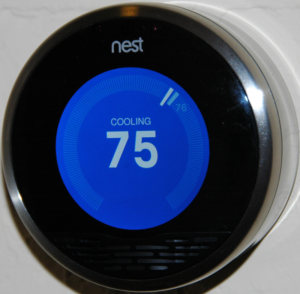 As winter approaches, we’re all wondering how much our heating bill is going to cost us this year. Every year, it seems it gets more and more expensive to just stay warm.
As winter approaches, we’re all wondering how much our heating bill is going to cost us this year. Every year, it seems it gets more and more expensive to just stay warm.
Even when you think you’re monitoring your heat and cooling usage, the utility bill is through the roof. If you have had any experience with this, here are a few super simple tips to keep you from emptying out your wallet every time the bill comes.
Programmable Thermostat
While it may seem like an expensive option, upgrade to a programmable thermostat. This will let you schedule times that you’re out of the home, and your thermostat can be set to colder or warmer temperatures than you would be comfortable living in.
If you work out of the home like most people, there is 9-10 hours a day that you could be saving on energy costs. There are even new smart thermostats that learn your typically schedule and behaviors and adjust the temperature accordingly!
Seal Windows and Doors
For any time of year, sealing any cracks in your home is a great way to reduce costs. By removing any air that gets in the house, the heating and cooling system has to make less effort to keep the desired temperature in the home.
The less the heater or the air conditioning has to kick on, the lower your utility bill.
Unplug
Do you have something you don’t use frequently, but keep plugged in? Unplug it! Don’t keep your chargers plugged in when they’re not in use, and unplug any large appliances you don’t use frequently.
Just be cautious of how many items you have plugged in, and you’ll notice a drop in your utility costs.
Let It Air Dry
One of the biggest energy consumers in many homes is the dryer. Even the energy-efficient models consume a lot of electricity or gas to heat the clothing to full dryness.
Instead you can air dry your clothes (outside if the weather permits) or inside, by laying them flat on surfaces or hanging them up on a rack or other convenient place.
If you have to have that “freshly dried” smell, you can time dry your clothing or turn it to the air dry setting.
Off-Peak Hours
Check with your local power company to verify, but most of these companies have peak hours that they charge more for kilowatts used. These are usually hours that everyone is home and awake- 6am to 9am, and 2pm-8pm (give or take).
During these hours, the price per kilowatt is increased slightly. If you really want to be a utility budget ninja, do your major energy usage during off-peak hours. Set the dishwasher to run at 11am while you’re at work, or set your clothes to dry overnight and fold them in the morning.
These are just a few suggestions on how to save money and energy, and there are plenty of other ways. Just get creative, and you will save money and the planet while you do so

